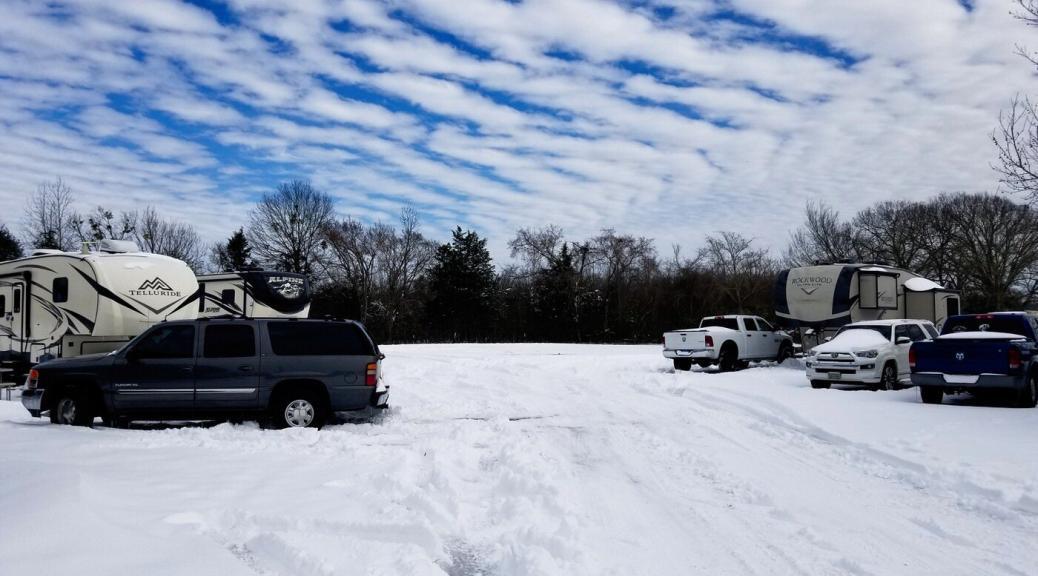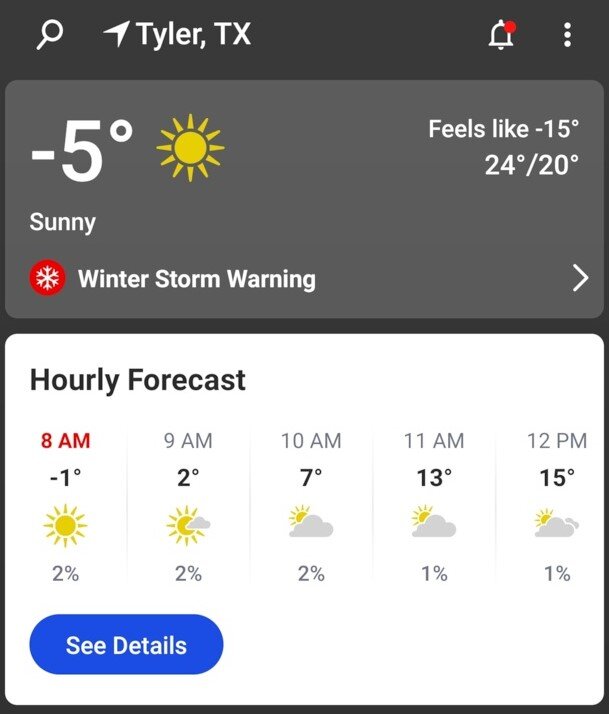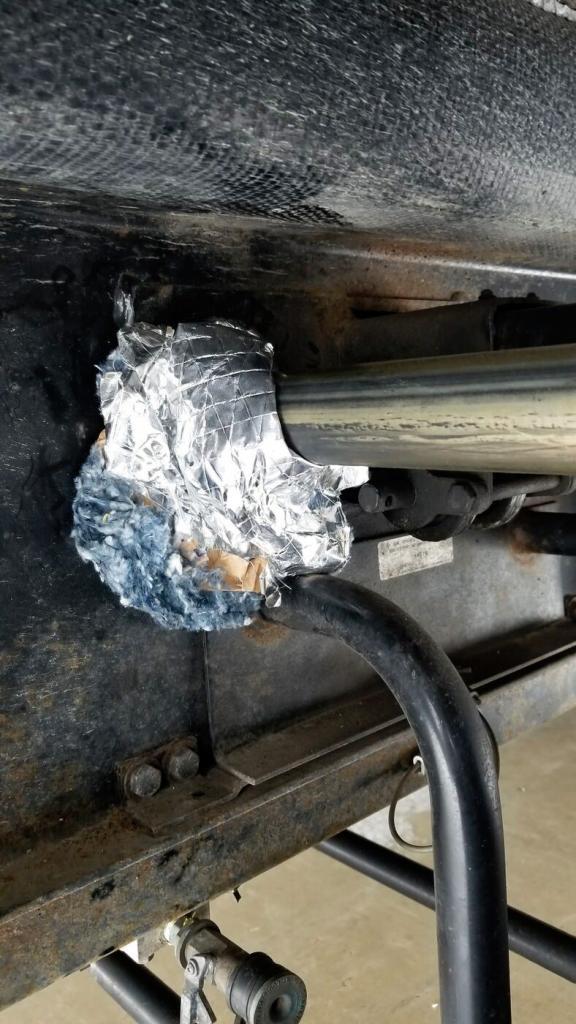
Lessons Learned – Winter Camping Revisited
As I write this we are on the 8’th day of extreme winter weather in North East Texas. During this week, we’ve had temperatures below 0°F (-5°F at the nearby airport) and it has snowed multiple times resulting in about a foot of total snowfall. At 201 hours below freezing, we beat the prior record in this area which was set sometime in the late 1800’s. While I realize many people from the northern states will say, so what – we get that all the time – I have lived in Texas for most of my life and I can tell you this much snow and the low temperatures is very unusual for this part of the country. We just don’t have the infrastructure to deal with it as well as other states might.

What made this event particularly difficult was that nearly the entire state was blanketed in freezing weather with lots of snow and even worse thick ice from freezing rain. Travel became extremely hazardous and utilities like power and water were out for millions of people – often for days. The finger pointing between the utility companies, politicians and the media has been intense. While I think mistakes were made, in the end this was a once in 100 year storm pattern that I may well not see again in my lifetime.
Speaking of mistakes, we made a few as well but overall it was a good learning experience and we were blessed to only lose power for about 2 hours early on. Our first mistake was assuming the actual weather would not be as bad as they forecast. It’s common in Texas to get a bad forecast a few days ahead of time and by the time we get to the forecast day, the new forecast is much better. This is especially true when snow is forecast as it feels like it only snows once for every 10 forecasts of snow and that is usually no more than a dusting. This time the newer forecasts just kept getting worse and the actual weather ended up being worse than forecast.
In many ways, living fulltime in an RV has advantages over living in a sticks and bricks house during emergency situations like this, particularly if you have a rig designed for colder weather like we do. In order to survive you need to be prepared and have backups for critical infrastructure – power, water, heat, sewer, etc. An RV is the perfect venue to have multiple sources for each of those but you need to know how your equipment works and how to avoid or work around any limitations you have. Also, be sure you have a hairdryer! We’ve needed one in cold weather to unstick frozen sewer connections, open a stuck sewer valve (happened in Colorado even before this storm), and this time to open outside storage compartment doors that froze stuck. Make sure you have one on your required “tools” list if you plan to RV in freezing temperatures.
Although our insulation is not as good as most houses, we have much less space to keep warm. Luckily for us, we also have 3 sources of heat. When temperatures are above 40°F we have heat pumps on our air conditioners. These work really great for keeping the RV warm with moderately cool temperatures. Once the outside temperatures drop below about 40°F, we usually switch to our fake fireplace and 2 ceramic space heaters. These work quite well as long as you have shore power but they are very power hungry. One issue we have with the fireplace and one of our space heaters (one that has a digital thermostat) is that if there is a power loss, when the power is restored these heaters stay off and have to be manually turned back on. That’s something really important to keep in mind if you won’t be around to turn them back on. Yes, I know – you really shouldn’t leave them on and unattended. Be sure you get ones with over temperature sensors and tip over sensors and keep flammable materials away from them. Another issue is that when we added Solar and updated our inverter (provides 110 VAC from our batteries) we configured most of the plugs in the rig to run off the inverter when shore power is lost. A side effect of this is that the ceramic heaters, if on a plug supplied by the inverter, will continue to run with a loss of shore power but that will run our batteries down very quickly and could even cause the inverter to shut down due to an overload. Because of this, we installed a plug in the bedroom that is not on the inverter and we use a plug in the kitchen pantry that was installed for a coffee machine that is also not on the inverter. With a loss of shore power, our heat source will then drop back to our propane furnaces as a fail safe.
You might wonder why we don’t use our propane furnaces for heat before some of the other options. First, they use a huge amount of propane. With temperatures this cold our propane would only last about a week and in weather like this, propane will sell out very quickly. In fact, half way through the weather event, the park we are in has sold out and we don’t expect to be able to get more for at least another week. We’ve heard there isn’t any available in the entire area. After that, we turned off the water heater and put it into an “anti-freeze” mode that uses 12 VDC power to keep it from freezing to reduce propane consumption. Otherwise, even though it is tankless, it will light the burner on occasion to keep it from freezing. Second, the heater in the bedroom works pretty well but the one in the living room barely outputs any air and really doesn’t warm the room much. I’ve traced the ducts and as far as I can tell there are no obstructions – I think a lot of the air goes to heat the basement even though I’ve closed those down some to try to help. We do run the living room heater enough to keep the basement above 35°F. Last year I added a separate thermostat that controls that heater based on temperature sensors in the basement. Before I had to guess what the temperature was and set the indoor living room thermostat to try to keep the basement above freezing. Now I know that I don’t need nearly as much heat down there to start above freezing as I thought and we are using much less propane.
After investing a good deal of money in solar and lithium batteries I sometimes wonder if it was money well spent. Well after snowmageddon 2021 I’m glad we had them even though we didn’t need it – this time. Again it’s about having options. During the day, even when it was cloudy, the solar panels provided enough power to charge the batteries and power the lights so we would have been ok if we lost shore power – if not a bit cold since our space heaters would no longer work. Our propane furnaces need 12 VDC to run and solar could keep those going without shore power. The major reason for solar and lithium, however, was to power the inverter to provide 120 VAC to the refrigerator. It takes a lot of power to keep a residential refrigerator running. We didn’t lose power for a significant time so we never got to test how long we’d actually be able to run the refrigerator given some level of charging from the solar. We expect it would last for 2-3 days but someday we’ll test it so we know for sure. In the case of cold weather we’d likely prioritize running the propane heat to keep the bedroom and basement warm and the battery would probably run them forever – or at least until we ran out of propane. We also have a gasoline generator that we didn’t use. But we made another mistake there as I didn’t fill up our gas can. We could have run it for a few hours on what I had but I really should have filled up the can before all this hit.
We encountered the problem I mentioned in the prior winter lessons learned post where lithium batteries can’t be charged below 32°F. Since that time I had added a light bulb “heater” on a thermostat in the front battery bay. The light bulb works great down to about 20°F but then it can’t keep the battery temperatures above freezing. When that happens the batteries not only won’t charge but 12 VDC loads are also not supplied by the 120 VAC to 12 VDC converter/charger even if shore power is available. That means the batteries will likely run down in a few days because they can’t recharge until the battery temperature goes above freezing. I think the solution will be to have a very small ceramic heater or possibly some small heat pads to use when outdoor temperatures are expected to go below about 25°F. ** Specific information for our rig only ** It would also be possible to turn off the battery disconnect switch and then install a large jumper (car jumper cables) across the over voltage contactor so that loads can be driven by the inverter / charger. Another method would be to turn off the battery system at the control panel and then turn on the old converter that came with the rig. Neither method would automatically fail over back to the batteries if shore power was lost, however.
We went into this weather event feeling pretty good with our propane level at about 80%. With the extreme cold, we were down to about 50% half way through the event – about 4 days in. That basically means one of our two 40# tanks was empty. We found out the park we were in had propane and they were filling tanks so I ran out and got the empty tank loaded in the truck only to find out the truck wouldn’t start (more about that later). We carried it over, were one of the last to get filled before the park ran out of propane, and then one of our neighbors took pity on us and brought us back to our trailer in his truck with our now full tank that weighs about 70 lbs. full. Thanks David!!
After that I began to wonder why the back part of the basement stayed colder than the front part – particularly since the back part has more insulation than the front. One thing that always bothered me was a large opening on each side of the frame in the back where the slide actuators go through. They have to be large so that there is play as the slide moves in and out so they can’t be fully sealed off. I took some insulation and stuffed it into the holes and it made a huge difference. No longer did we get some intermittent freezing of the kitchen faucet pipes in the basement but it also significantly reduced the propane heater usage needed to keep the basement above 35°F. I’m searching for a way to weather seal those holes more permanently while still allowing their movement as needed to open and close the slides.


Knowing that water might freeze or if the park lost power we could be without water for a while we decided to fill our water tank half full. Up to this point, water in the park has remained available with a couple of relatively short times where we think it was actually frozen lines (like when the power went out for 2 hours). Of course, having water in the water tank didn’t always help when lines froze inside the basement but it was nice to have water available when we needed it. Sealing off the slide actuators as mentioned before stopped these lines from freezing so that is definitely something to continue in cold weather going forward. Next time I will fill the tank full as we heard there could be longer term outages at the park once things start to thaw out. Unfortunately after the cold weather started, we were no longer able to add water to the tank even when park water was on. We still haven’t figured that out yet but it likely will resolve once the temperatures rise.
One thing we did right was to close off our internal sewer valves and allow water to collect in our tanks. With tank heaters on, it’s better to have some water in them anyway but with them closed there isn’t a slow release of water every time a sink is used that might freeze in the sewer line. We can open them as needed to release a lot of water at once or wait until the outside temperature is above freezing as long as our holding tanks don’t reach 100%. Some people suggest dripping a faucet to prevent freezing like you would in a regular house. I personally think that is a bad idea since you would need to leave valves open to the sewer or at least monitor tank levels carefully. We a slow drip going down the sewer hose it’s highly likely the water will start to freeze in the hose eventually causing the tanks to fill anyway. One note about closing the valves – we left the external valve (where the sewer hose connects) open and only closed the internal valves that are in the heated basement. Last time we left the external valve closed in freezing weather, we had to use our hairdryer to thaw it out so we could dump before leaving Colorado.
Finally, one thing we should have paid more attention to was our diesel truck. When the storm was just about to hit we filled up when we saw a station with a decent price – we were in a time where prices were going up pretty fast. That was a good thing but we didn’t add anything to the fuel to keep it from gelling in cold temperatures. Diesel fuel will start to cloud as the temperature drops below 32°F and can gel around 10°F. Cheaper fuel can gel at higher temperatures. The bad thing is, we talked to friends the day before the storm hit and he asked if we put in any additive. I said no, we’ve been in temperatures down to 0°F before without issues. Well, we had been in New Mexico / Colorado at those temperatures. It’s likely that their diesel had been pre-treated for freezing temperatures. In Texas and other states where extended temperatures below freezing is not that common (or when buying cheaper fuel) then you cannot count on it being pre-treated. The lesson learned is to always add a diesel fuel supplement to prevent gelling that does not contain alcohol if the temperatures will fall below 32°F unless you know for sure the fuel in the tank is pre-treated. Water in the fuel can also cause problems so you should probably drain water from the fuel filter regularly as well in freezing weather.
This time we got lucky and only lost power once for about 2 hours in the middle of the night. It quickly got down to about 55°F inside the trailer and it took hours for it to get back to even 65°F. It could have been much worse if we had lost power for several days as did many across the state. At this point we have one more night of temperatures in the teens then we should stay above freezing for the next 10 days at least. Maybe the worst of this winter will be over for Texas this year. At any rate, next time we are going to encounter temperatures below freezing for an extended period, we’ll be better prepared!
5 thoughts on “Lessons Learned – Winter Camping Revisited”
Jerry,
I can’t tell you how much that I enjoyed reading your post. You were very descriptive in your writing which enabled me to visualize all that you were describing. You must have a very well-built and designed RV. I can agree with you – global warming etc I believe that we may have more periods of extreme heat in the summer, and cold winters.
Are you satisfied with the manufacturer and model RV that you have?
We are both O K in north Georgia, but our sons are suffering a bit in Cedar Park and Georgetown. We all hope that this will end soon.
Our very best to you and Anna. Stay warm, compadre!!!
Sorry Bill, I did get a bit wordy. A lot of this is for us to remember what we did when we get into a similar situation in the future. Hopefully some of it may help others.
We are happy with our Luxe but as with all RVs they have their weak points. This story could have been much different had we lost power for a significant amount of time.
Glad everyone is ok, this weather should improve a great deal over this weekend and into next week.
Wowza- that was quite a lengthy informative read! I’m glad that everything ended up working out okay for y’all. Maybe you should consider spending winter months in Arizona or South Florida! STAY WARM
Yes, I think we have to go further south or west. We thought about the Texas coast this year but even that wouldn’t have escaped this storm.